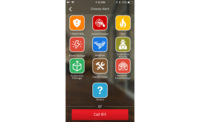While mass notification and emergency communication may be mirror images of each other in terms of the direction of communication, the terms are sometimes used interchangeably.
“The same devices could do both but the function is either from the far end in to the professional or from the professional out toward the edges,” says Samuel Shanes, CEO, Talkaphone, Niles, Ill.
Regardless of the communication path, the truth is that these systems are rapidly evolving to take advantage of the latest in technology. Of particular note in driving this evolution are mobile technologies and the ability — not to mention the necessity — to integrate a wider array of systems into mass notification systems (MNS) and emergency communication.
Going Mobile
With cord-cutting continuing to be a growing trend, it’s not surprising that mass notification and emergency communication solutions are increasingly relying on cellular and other wireless technologies. The ubiquity of smartphones provides greater convenience.
“Smart devices and cellphones offer many pros for usage in the emergency communications market,” says Jana Rankin, CEO, VuTeur, Austin, Texas. “According to the Pew Research Center, 92 percent of American adults own a cellphone, and 90 percent say they ‘frequently’ carry their phone with them. A staggering 82 percent say they never or very rarely turn their phones off. Cellular communication leads to an increased chance of messages being received in the event of an emergency. Smart device usage across the globe makes this form of communication a viable option for asset protection and incident response in today’s world.”
However, as is the case with any technology, there are pros and cons.
“Wireless used to be considered if you couldn’t run a wire, then it was better to be wireless. Cellular still faces that challenge. In a real emergency, it’s going to become challenging to rely on cellular,” Shanes says, citing his own experience being in London on 9/11, when he wasn’t able to get in touch with his wife using his cellphone for a week because of the strain on cellular networks.
IP wireless, on the other hand, offers advantages.
“You sort of have control of your own channels and destiny to some extent if your system is set up to prioritize these types of events,” Shanes adds.
Because there is no single technology option that provides a solution for every application, the best way for integrators to address the pros and cons of the various communication modes is to design and implement multi-modal, multi-layered MNS.
“Relying on just one method in an emergency could result in a relatively large portion of the targeted population not receiving the message,” says Marla Reynoso, commercialization and product marketing manager, Eaton, Cleveland. “Utilizing a multi-layered MNS can produce a reliable and robust design to achieve an organization’s emergency communication objectives of successfully reaching the affected audience with the right message at the right time.”
Integration
The migration from analog to IP in both emergency communication and mass notification enables systems to be integrated with other systems and devices, such as cameras, card readers, VMS and others, to become part of a larger system in a seamless way.
“By doing your part with integration, you’re able to be leveraged and to leverage what you do in a much more dynamic and powerful way,” Shanes says. “That’s going to accelerate … all these things get powerfully integrated, and more and more of that is going to occur.”
There are multiple ways that information is shared across a large enterprise to improve collaboration and support normal, day-to-day business activities. Yet during an emergency when the right information needs to get to the right people at exactly the right time, it is surprising that these ubiquitous notification vehicles are not used, says Mary Foster, director, strategic business development, Honeywell Security, Huntington, N.Y.
“Most of the time, we see that it is because emergency monitoring systems, such as fire and security, have their own discrete method of notification, which may not be linked to common ways people communicate, such as emails, phones, social media, text messages, etc.,” she says. “Depending on the type of emergency, the response can be complex and may require input from people not immediately at the site or from public safety officials. End users are demanding that the right information is quickly disseminated to the appropriate people to protect lives and avoid loss.”
Integration is especially important in the age of the Internet of Things, where anything that can be connected to a network will be.
“Many systems are now leveraging the power of reaching existing computer networks and the Internet for traditional MNS elements, such as outdoor giant voice or indoor voice evacuation systems,” Reynoso says. “Interoperability is also a key technology trend that impacts the design and implementation of an effective mass notification system. Many organizations have adopted different disparate systems over the years, and there is a big push to integrate the systems with one unified interface to manage all the systems.”
Therefore, integration will be a main driver of the industry’s concept of mass notification as the technology advances.
“The mass notification ecosystem will be the next buzzword in the industry. An open mass notification software platform will play a central role in integrating, managing and streamlining the notifications across a variety of on-premises systems and mobile devices,” Foster says.
However, to be successful, integrations must be supplemented by the human factor.
“Regardless of the device that triggers the system, it will be the integrator’s job to define protocols and educate your clients when and how to use the system,” says Kevin McCarthy, national sales manager, Emergency24, Des Plaines, Ill.
Planning and Deployment
When installing a MNS, integrators have to complete a needs assessment that aligns with the customer’s emergency response plan, which should serve as a basis for deploying a system that will meet the requirements of an organization or facility.
“In addition to finding out what type of systems and equipment can be leveraged, integrators can also determine the right technology,” Reynoso says. “For example, what type of communications should be used — hard-wired, wireless, or a combination of the two — would depend on the environment of the site.”
Considering the possible integrations and bringing more people into the decision-making process are also keys to successful MNS deployments.
“The most valuable asset that an integrator can provide is a well-planned approach to strengthening existing investments and recommending new technology to an organization,” Rankin says. “It is also very critical to involve multiple stakeholders from the initiation of such a discussion, as everyone — both public and private entities — should have a seat at the table to best approach building a comprehensive solution.”
One final piece of advice for integrators completing a needs assessment is to consider what’s necessary not only today but tomorrow as well, says Daniel Graff-Radford, chief product officer, OnSolve, Ormond Beach, Fla.
“It’s important for integrators to not only think through their most immediate use case, but to be predictive where possible about future needs,” he says. “This helps ensure integration with vendors with functionality that will support all needs over time. This ensures that technology solutions remain scalable and manageable.”






